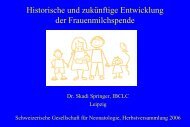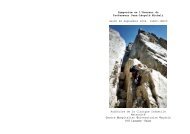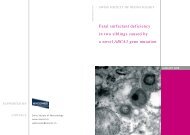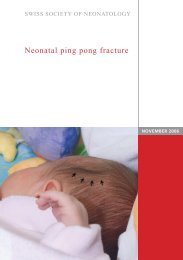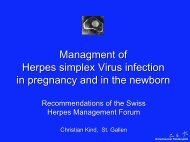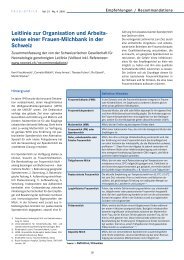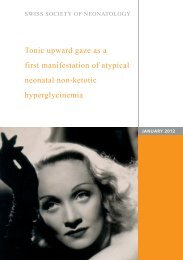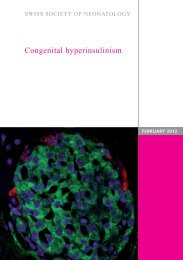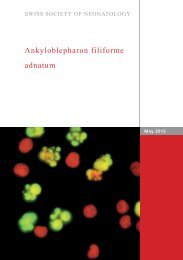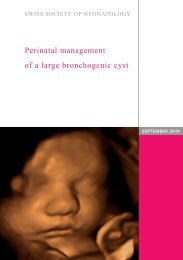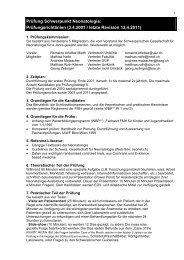Empfehlungen zur Prävention und Therapie von Termin- und knapp ...
Empfehlungen zur Prävention und Therapie von Termin- und knapp ...
Empfehlungen zur Prävention und Therapie von Termin- und knapp ...
Erfolgreiche ePaper selbst erstellen
Machen Sie aus Ihren PDF Publikationen ein blätterbares Flipbook mit unserer einzigartigen Google optimierten e-Paper Software.
Vol. 24 Nr. 1 2013<br />
<strong>Empfehlungen</strong><br />
postnatale Überwachung während 48 St<strong>und</strong>en<br />
indiziert ist, falls ein zusätzlicher Risikofaktor<br />
für eine neonatale Infektion vorliegt<br />
(Frühgeburtlichkeit vor 37 0 / 7 SSW,<br />
prolongierter Blasensprung > 18 St<strong>und</strong>en,<br />
Zeichen einer Chorioamnionitis) 1), 6) . Aufgr<strong>und</strong><br />
der hohen Rezidivrate einer GBS-<br />
Besiedelung erscheint es sinnvoll, den<br />
Nachweis einer früheren GBS-Besiedelung<br />
(z. B. während einer früheren Schwangerschaft)<br />
ebenfalls als Risikofaktor zu werten<br />
24), 25) .<br />
Dauer der Antibiotikatherapie bei neonatalem<br />
Infektverdacht: Da die klinischen<br />
<strong>und</strong> laborchemischen Zeichen einer möglichen<br />
neonatalen Infektion unspezifisch sind<br />
<strong>und</strong> bei symptomatischen Neugeborenen im<br />
Zweifelsfall eine Antibiotikatherapie begonnen<br />
werden muss, ist es wichtig, die Notwendigkeit<br />
der <strong>Therapie</strong> nach 48 St<strong>und</strong>en<br />
zu reevaluieren. Aufgr<strong>und</strong> <strong>von</strong> Klinik, negativen<br />
Kulturen <strong>und</strong> laborchemischen Parametern<br />
kann nach dieser Zeitspanne meist<br />
eine neonatale Infektion mit genügender<br />
Sicherheit ausgeschlossen <strong>und</strong> die Antibiotikatherapie<br />
gestoppt werden 7), 16) , 20)–23) . Die<br />
mehrfache Beobachtung, dass eine zu<br />
lange weitergeführte Antibiotikatherapie<br />
(> 5 Tage) mit vermehrten Todesfällen <strong>und</strong><br />
nekrotiserender Enterokolitis bei Frühgeborenen<br />
einhergeht, unterstreicht die Bedeutung,<br />
die empirisch begonnene Antibiotikatherapie<br />
bei fehlenden Zeichen (negative<br />
Kulturen, fehlender Anstieg <strong>von</strong> laborchemischen<br />
Parametern wie z. B. CRP) rechtzeitig,<br />
d. h. nach spätestens 48–72 Std.<br />
abzusetzen 26)–28) .<br />
Der positiv <strong>und</strong> negativ prädiktive Wert verschiedenster<br />
bisher untersuchter Laborparameter ist<br />
betreffend Früherkennung einer neonatalen Infektion<br />
ungenügend, um die Frage zu beantworten,<br />
ob eine Antibiotikatherapie notwendig ist oder<br />
nicht 7), 9), 16)–20) . Aus diesem Gr<strong>und</strong> erscheint uns eine<br />
allgemeine Empfehlung <strong>zur</strong> Bestimmung der Infektionsparameter<br />
im Blut nicht gerechtfertigt. Diese<br />
Empfehlung deckt sich mit den neuen <strong>Empfehlungen</strong><br />
aus Australien <strong>und</strong> Neuseeland 11) . Auch in den<br />
neuen <strong>Empfehlungen</strong> der AAP werden die Infektionsparameter<br />
nur für die Beurteilung der <strong>Therapie</strong>dauer,<br />
nicht aber für den Entscheid des <strong>Therapie</strong>startes<br />
benutzt 7) . Diverse Publikationen zeigen<br />
einen hohen negativ prädiktiven Wert für im Verlauf<br />
bestimmte Infektionsparameter, welche erlauben,<br />
die empirisch begonnene Antibiotikatherapie zu<br />
beenden (siehe oben: Dauer der Antibiotikatherapie<br />
bei neonatalem Infektverdacht) 16), 20)–23) .<br />
Referenzen<br />
1) Centers for Disease Control and Prevention. Prevention<br />
of perinatal group B streptococcal disease.<br />
MMWR 2010; 59: 1–32.<br />
2) Weston EJ, Pondo T, Lewis MM et al. The Burden of<br />
invasive early-onset neonatal sepsis in the United<br />
States, 2005-2008. Pediatr Infect Dis J 2011; 30:<br />
937–941.<br />
3) Kenyon S, Boulvain M, Neilson JP. Antibiotics for<br />
preterm rupture of membranes. Cochrane Database<br />
Syst Rev. 2010 Aug; 4; (8): CD001058.<br />
4) Daley AJ, Isaacs D, Australian Study Group for Neonatal<br />
Infections. Ten-year study on the effect of<br />
intrapartum antibiotic prophylaxis on early onset<br />
group B streptococcal and Escherichia coli neonatal<br />
sepsis in Australasia. Pediatr Infect Dis J 2004;<br />
23: 630–634.<br />
5) Vergnano S, Menson E, Kennea N et al. Neonatal infections<br />
in England: the NeonIN surveillance network.<br />
Arch Dis Child Fetal Neonatal Ed 2011; 96: F9–F14.<br />
6) Policy Statement of the American Academy of Pediatrics.<br />
Recommendations for the prevention of<br />
perinatal group B Streptococcal (GBS) disease.<br />
Pediatrics 2011, 128: 611–6.<br />
7) Clinical report of the American Academy of Pediatrics.<br />
Management of neonates with suspected of<br />
proven early-onset bacterial sepsis. Pediatrics<br />
2012; 129: 1006–15.<br />
8) Escobar GJ, Li DK, Armstrong MA et al. Neonatal<br />
sepsis workups in infants ≥2000 grams at birth: A<br />
population-based study. Pediatrics 2000; 106:<br />
256–263.<br />
9) Ottolini MC, L<strong>und</strong>gren K, Mirkinson LJ et al. Utility<br />
of complete blood count and blood culture screening<br />
to diagnose neonatal sepsis in the asymptomatic<br />
at risk newborn. Ped J Inf Dis 2003; 22 (5):<br />
430–434.<br />
10) Bromberger P, Lawrence JM, Braun D. The influence<br />
of intrapartum antibiotics on the clinical spectrum<br />
of early-onset group B streptococcal infection in<br />
term infants. Pediatrics 2000; 106: 244–250.<br />
11) Clifford V, Garland SM, Grimwood K. Prevention of<br />
neonatal group B streptococcus disease in the 21st<br />
century. J Paed Child Health 2012; 48: 808–15.<br />
12) P de Man, Verhoeven BA, Verbrugh HA et al. An<br />
antibiotic policy to prevent emergence of resistant<br />
bacilli. Lancet 2000; 355 (9208): 973–8.<br />
13) Manzoni P, Farina D, Mallet E et al. Riks factors for<br />
progression to invasive fungal infection in preterm<br />
neonates with fungal colonization. Pediatrics 2006;<br />
118 (6): 2359–64.<br />
14) Connel TG, Rele M, Cowley D et al. How reliable is<br />
a negative blood culture result? Volume of blood<br />
submitted for culture in routine practice in a<br />
children’s hospital. Pediatrics 2007; 119: 891–896.<br />
15) Stoll B, Hansen N, Sánchez P et al for the Eunice<br />
Kennedy Shriver National Institute of Child Health<br />
and Human Development Neonatal Research Network.<br />
Early-onset neonatal sepsis: The burden of<br />
group B Streptococcal and E.coli disease continues.<br />
Pediatrics 2011; 127 (5): 817–826.<br />
16) Benitz WE. Adjunct labarotory tests in the diagnosis<br />
of early-onset neonatal sepsis. Clin Perinatol 2010;<br />
37: 421–438.<br />
17) Buckler B, Bell J, Sams R et al. Unnecessary workup<br />
of asymptomatic neonates in the era of group B<br />
streptococcus prophylaxis. Inf Dis Obst Gyn 2010.<br />
18) Jackson GL, Engle WD, Seldelbach DM et al. Are<br />
complete blood cell counts useful in the evaluation of<br />
asymptomatic neonates exposed to suspected chorioamnionitis?<br />
Pediatrics 2004; 113 (4): 1173–1180.<br />
19) Newman TB, Puopolo KM, Wi S et al. Interpreting<br />
complete blood counts soon after birth in newborns<br />
at risk for sepsis. Pediatrics 2010; 126 (5):<br />
903–909.<br />
20) Ng PC, Lam HS. Diagnostic markers for neonatal<br />
sepsis. Curr Opin Pediatr 2006; 18: 125–131.<br />
21) Benitz WE, Han MY, Madau A et al. Serial serum<br />
C-reactive protein levels in the diagnosis of neonatal<br />
infection. Pediatrics 1998; 102: e41.<br />
22) Pourarous M, Bada HS, Koreones SB et al. Significance<br />
of serial C-reactive protein responses in<br />
neonatal infection and other disorders. Pediatrics<br />
1993; 92 (3): 431–435.<br />
23) Stocker M, Fontana M, el Helou S et al. Use of<br />
Procalcitonin-guided decision-making to shorten<br />
antibiotic therapy in suspected neonatal early-onset<br />
sepsis: Prospective randomized intervention<br />
study. Neonatology 2010; 97: 165–174.<br />
24) Cheng PJ, Chueh HY, Liu CM et al. Risk factors for<br />
recurrence of group B Streptococcus colonization<br />
in a subsequent pregnancy. Obstet Gynecol 2008;<br />
111: 704–709.<br />
25) Turrentine MA, Ramirez MM. Recurrence of group<br />
B Streptococci colonization in subsequent pregnancy.<br />
Obstet Gynecol 2008; 112: 259–264.<br />
26) Alexander VN, Northrup V, Bizzaro MJ. Antibiotic<br />
exposure in the newborn intensive care unit and the<br />
risk of necrotizing enterocolitis. J Pediatr 2011; 159:<br />
392–397.<br />
27) Cotton CM, Taylor S, Stoll B et al. Prolonged duration<br />
of initial empirical antibiotic treatment is associated<br />
with increased rates of necrotizing enterocolitis<br />
and death for extremely low birth weight<br />
infants. Pediatrics 2009; 123: 58–66.<br />
28) Kuppala VS, Meinzen-Derr J, Morrow AL et al. Prolonged<br />
initial empirical antibiotic treatment is associated<br />
with adverse outcomes in premature infants.<br />
J Peditr 2011; 159: 720–725.<br />
Korrespondenzadresse<br />
Dr. med. Martin Stocker<br />
Leitender Arzt Neo/Ips<br />
Kinderspital<br />
6004 Luzern<br />
martin.stocker@luks.ch<br />
Die Autoren haben keine finanzielle Unterstützung<br />
<strong>und</strong> keine anderen Interessenkonflikte<br />
im Zusammenhang mit diesem Beitrag<br />
deklariert.<br />
13



